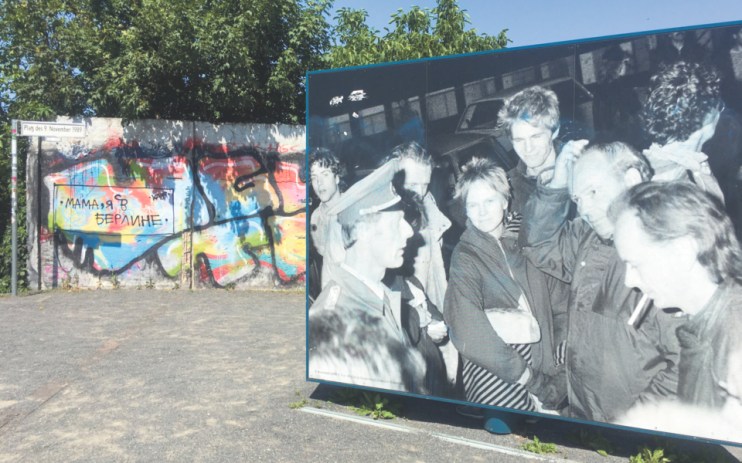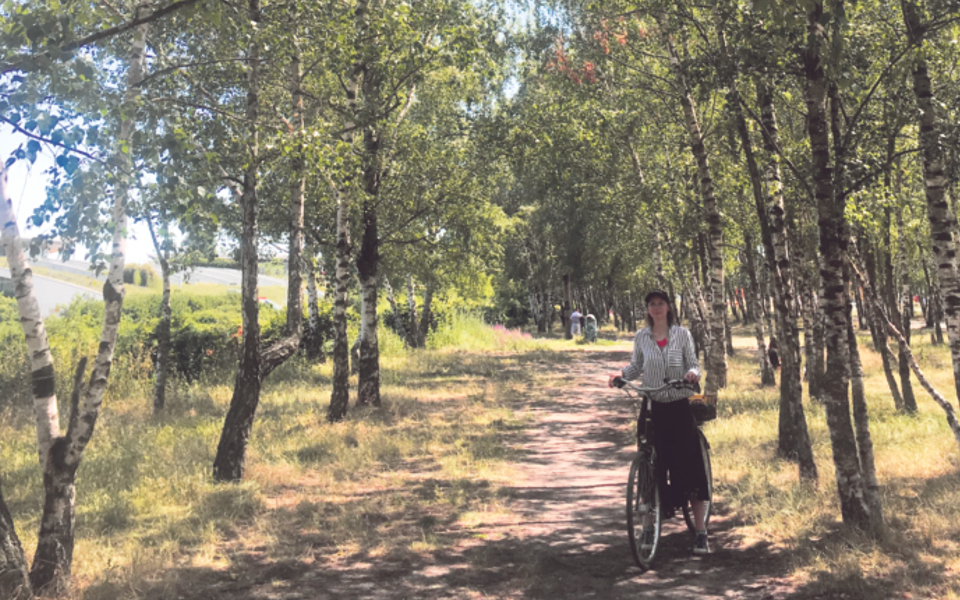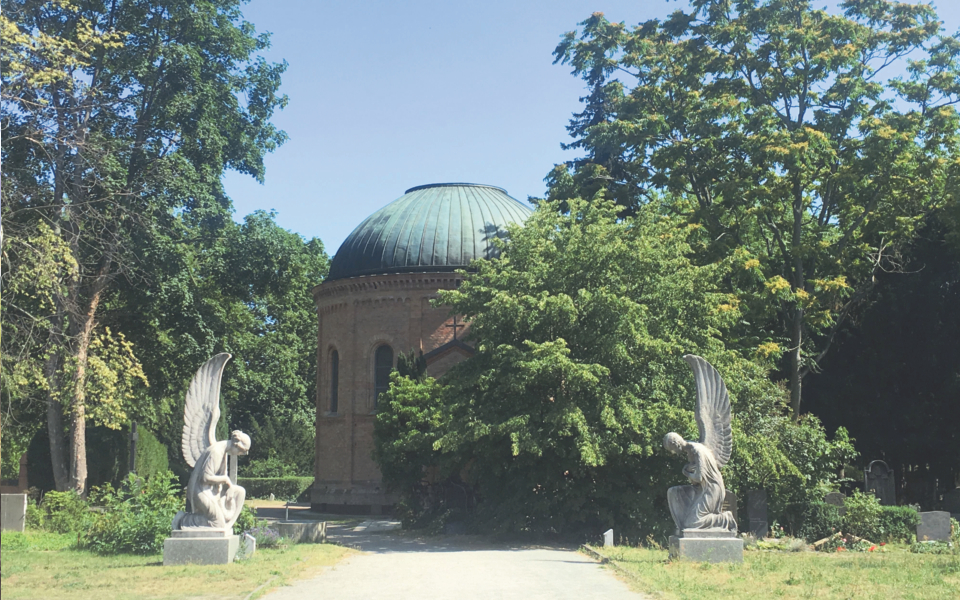How the Berlin Wall still influences culture and commerce

Nature is reclaiming the Death Strip. Pioneer birch trees have self-seeded, creating a winding, shady memorial that cuts through the heart of Berlin. There are cherry blossoms too, a gift from the Japanese government. But it is the slim, silvery trunks of the birches, and the dappled, dancing shadows they cast on the path, that shape the view.
Graffitied chunks of the checkpoint at Platz des 9 November 1989 are just above me. They stand side by side with greater-than-life-size photos of one night 30 years ago when human error led to the unplanned fall of the Berlin Wall. The concrete and barbed wire barricade divided city districts and families, the capitalist west from the communist east. The 30m wide scar through the city, 155km in length, still characterises much of Berlin’s urban landscape, and influences development today.

I don’t remember the day the wall fell. I’ve seen the jubilant footage and photos, of course, but like many millennials born in the dying years of the Soviet Union, it’s an event I mostly learned about in school.
I came to Berlin as the 30th anniversary approached in 2019 to cycle the wall, and to hear the stories of those lived alongside it. What I found was that even in spaces where the structure is long gone, the ghost of the wall still casts its shadow.
To understand why the wall came into being in the first place, you have to go back to the 1940s. Berlin lay deep within East Germany, and after WW2 Stalin expected to be given control. When the city was divided between the Allied powers, his response was to try and starve out the Americans and British to make them leave. The Berlin Airlift transformed West Berlin overnight into a symbol of western bravery against Soviet oppression; the city took on a propaganda value which made it nigh on impossible for any party to negotiate a withdrawal.
In the 1950s, some 3.5 million East Germans entered West Berlin, collected their refugee papers, and then legally left the Soviet Union. The population drain was a serious concern for the East German authorities, so from 1961 they encircled West Berlin with an increasingly impenetrable wall. They implemented a shoot to kill policy. Other would-be escapees were killed in accidents or committed suicide having failed to cross. According to the Gedenkstätte Berliner Mauer (the Berlin Wall memorial), more than 140 people died.

I picked up my rental bike and met tour guide Lauren at Berlin on Bike in Kulturbrauerei, a beautifully restored red brick brewery in the Prenzlauer Berg district. It’s estimated that there are 500,000 cyclists on Berlin’s roads every day, and the city has invested significantly in bike-friendly infrastructure to meet their demands. I’m not the bravest of cyclists, but the combination of well-planned cycle paths and bicycle-considerate motorists made for a stress-free start.
We zigzagged through predominantly residential areas of what used to be East Berlin. Unlike its western counterpart, there was no money for post-war reconstruction here. Poor immigrants lived in the densely populated tenement blocks beside the railway, many of the buildings fractured by bomb damage and bullet holes. Windows facing the death strip were bricked up, there were look-out posts in the attics, and soldiers stood guard on the roofs. It is estimated that one in three East Germans living here were being watched by the Stasi, but in spite of the constant fear, there was nevertheless a network of quiet resistance. The Zionkirche had a secret library of western literature; the Gethsemane Church was a meeting place for opponents of the regime; and venues such as the Sonntags Club gave a safe space to homosexuals and other persecuted groups.
When the wall fell, this was the cheapest real estate in the city: a land of squats, artists’ studios, and wild techno parties.
The Mauerpark — an extensive urban park built within the void left by the wall — hummed with the energy of open air karaoke singers, graffiti artists, and flea market traders. The war damaged buildings were yet to be demolished, and the centrally located land on which they stood was valuable. Then developers moved in, and a period of rapid gentrification began. Four fifths of those who lived here in 1989 have gone, priced out by a wave of expats.
The Mauerpark clings on, for now, but the well-heeled residents of the ever-increasing number of luxury flats surrounding it are in an ongoing battle with those Berliners for whom the slightly rundown park is both a memorial and a symbol of their resistance. Parking the bikes in the shade, we stopped for a beer at the Mauersegler beer garden and spoke about the rising cost of living, the bunker-like architecture of some of the latest flats, and attempts to ban buskers from playing.
We rode on beside the canal, where Europa City is now filling in dead land left by the removal of the wall. Dwarfed by new apartment blocks is one small guard tower, purchased by local residents to protect it from encroachment and demolition. It stands as a permanent reminder that not so long ago everything they did was being watched.

Around the corner is a second memorial to 24 year old Gunter Liftin. When the wall went up on 13 August 1961 (something that happened so quickly, so secretly, that even US intelligence didn’t see it coming), Gunter was working in West Berlin, but living in the east. Trapped by road blocks and barbed wire, he tried to escape by swimming across the canal. No official announcement had been made of the shoot to kill policy. Gunter was shot at the water’s edge with his hands in the air. He is buried in the St Hedwig’s Cemetery, besides what’s left of WW1 and WW2 graves ripped up by the wall. Churned up beyond the point of identification, all that remains is a plaque with the names of those known to have once been buried here.
The tour ended beside the Gedenkstätte Berliner Mauer. Here there’s the last intact stretch of grim concrete wall, and a sobering photo montage of all those who died attempting to cross to freedom.
It’s an uncomfortable place to stand even now. Yes, the wall fulfilled its purpose: it ended mass migration from East Germany, and as a result also calmed the flashpoint that was Berlin in the 1950s. The wall stabilised Europe, but in doing so it acknowledged an eternal divide in Berlin. It’s been estimated that it will take 55 years to reconnect the infrastructure divided between the two cities, so there’s at least another generation to go. And repairing fractured lives, fractured identities can take even longer still.
NEED TO KNOW
Rooms at Berlin’s Radisson Blu Hotel (www.radissonblu.com) start from EUR 128 per night for bed and breakfast. The guided Berlin Wall Bike Tour costs EUR 19 from Berlin on Bike (www.berlinonbike.de).